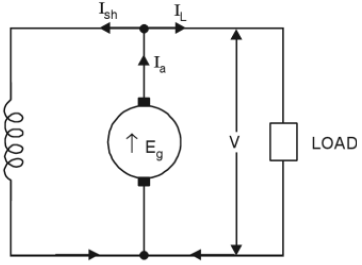60. If the flux per pole of a d.c. generator is halved but its speed is doubled, its generated e.m.f will
(i) be halved
(ii) remain the same
(iii) be doubled
(iv) be quadrupled
Answer: (ii) remain the same
61. Stray losses consist of
(i) magnetic and mechanical losses
(ii) magnetic and copper losses
(iii) mechanical and copper losses
(iv) none of the above
Answer: (i) magnetic and mechanical losses
62. Current-versus time graph for an ideal commutation is a
(i) straight line
(ii) parabola
(iii) hyperbola
(iv) none of the above
Answer: (i) straight line
63. The ideal commutation in a coil is not possible because each coil has
(i) resistance
(ii) inductance
(iii) capacitance
(iv) none of the above
Answer: (ii) inductance
64. In Fig. 5, the electrical efficiency is
(i)VIa/(EgIa)
(ii) VIL/(EgIa)
(iii) EgIa/(VIa)
(iv) none of the above
Answer: (ii) VIL/(EgIa)

65. In Fig. 5, the overall efficiency will be
(i) less than electrical efficiency
(ii) more than electrical efficiency
(iii) equal to electrical efficiency
(iv) none of the above
Answer: (i) less than electrical efficiency

66. Fig. 6 shows the various power stages of a d.c. generator. The loss at A is
(i) iron loss
(ii) friction loss
(iii) iron and friction losses
(iv) none of the above
Answer: (iii) iron and friction losses
67. In Fig. 6, the loss at B is
(i) iron loss
(ii) stray loss
(iii) friction loss
(iv) Cu loss
Answer: (iv) Cu loss
68. In a d.c. generator, the main function of compensating winding is to
(i) assist in commutation
(ii) reduce demagnetizing effect of armature reaction.
(iii) reduce distorting effect of armature reaction
(iv) eliminate reactance voltage
Answer: (iii) reduce distorting effect of armature reaction
69. The efficiency of a d.c. generator means its
(i) electrical efficiency
(ii) overall efficiency
(iii) mechanical efficiency
(iv) none of the above
Answer: (ii) overall efficiency
70. The overall efficiency of a d.c. generator is maximum when its variable loss is equal to
(i) constant loss
(ii) stray loss
(iii) iron loss
(iv) mechanical loss
Answer: (i) constant loss
71. In d.c. shunt generator, the constant losses is equal to
(i) stray losses
(ii) mechanical losses
(iii) stray losses plus shunt Cu loss
(iv) none of the above
Answer: (iii) stray losses plus shunt Cu loss
72. A 4-pole, lap-wound d.c. shunt generator has an armature winding consisting of 220 turns each of 0.004 Ω. The armature resistance is
(i) 0.5 Ω
(ii) 1 Ω
(iii) 0.025 Ω
(iv) 0.055 Ω
Answer: (iv) 0.055 Ω
73. In a long-shunt compound-wound generator, the shunt field is connected in parallel with
(i) armature
(ii) series field
(iii) parallel combination of armature and series field.
(iv) series combination of armature and series field
Answer: (iv) series combination of armature and series field
74. Wave-wound generators provide
(i) less current but more voltage
(ii) more current but less voltage
(iii) more current and more voltage
(iv) none of the above
Answer: (i) less current but more voltage
75. The commutator of a d.c. generator acts as
(i) an amplifier
(ii) a rectifier
(iii) a load
(iv) none of the above
Answer: (ii) a rectifier
76. In a d.c. generator, the eddy current power loss is
(i) directly proportional to thickness of each lamination
(ii) inversely proportional to thickness of each lamination
(iii) directly proportional to square of thickness of each lamination
(iv) none of the above
Answer: (iii) directly proportional to square of thickness of each lamination
77. In a practical d.c. generator, mechanical efficiency is
(i) less than electrical efficiency
(ii) more than electrical efficiency
(iii) equal to electrical efficiency
(iv) none of the above
Answer: (ii) more than electrical efficiency
78. In a d.c. generator, the relation among mechanical efficiency (ɳm), electrical efficiency (ɳe) and overall efficiency (ɳo) is
(i) ɳo = ɳm x ɳe
(ii) ɳo = ɳm/ɳe
(iii) ɳo = ɳe/ɳm
(iv) none of the above
Answer: (i) ɳo = ɳm x ɳe
79. The armature copper loss in a d.c. generator is a
(i) constant loss
(ii) variable loss
(iii) stray loss
(iv) none of the above
Answer: (ii) variable loss
80. The armature reaction in a d.c. generator can be increased by increasing the
(i) field current
(ii) armature current
(iii) data is insufficient
(iv) none of the above
Answer: (ii) armature current